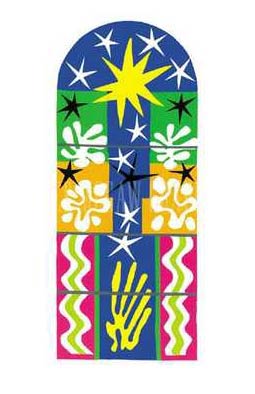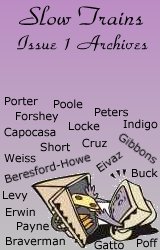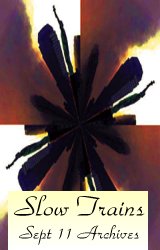
Miracles of Art
by Robert Gibbons
Equal to those miracles portrayed, certain works of art can transport, transform the viewer into similar, heightened realms. If God's hand were present during the writing of the Gospels, then an imprint is upon the panel of The Angel of the Annunciation, c. 1333, by Simone Martini at the National Gallery of Art in Washington. This painting, as much a sacred relic as it is a work of art, has the quality of an archetypal dream, its translucent golds & reds seeping into the screen of ancient wood.
Last week was the anniversary of my hiring at that gallery back in 1990, a privilege. For four years from my lowly position in the library, I visited works that gave solace, inspiration. For some reason I began to recollect the pleasures of museum-going: it is not just the sacred that can transform us, but secular visions, as well. Reminiscences arrived randomly, tangentially against that pivotal four-year experience at the NGA in Washington.
I recall a cross-country trip in 1974 that began by putting thumbs in the bronze eye-sockets of the Balzac at the Rodin Museum in Philadelphia. The day we visited the Barnes Collection we waited in line under an impressionist rain. Years later, when they renovated the building the best of the collection was exhibited for the first time in another venue, where else than in DC? It included the original Matisse murals, which did not fit the artist's projected measurements, but were ultimately improved upon by him.
During 1974, Watergate was at its height. I.M. Pei's grand East Building was still a blueprint when we parked at the unmetered construction site of its foundation & zipped over & through the staid West Building, where the image of Vermeer's Girl with the Red Hat dove from her frame, & accompanied us to California & Mexico. In Pasadena Max Beckmann's prepubescent nude appeared sexier than all the California girls in Long Beach, where we stayed for three weeks. In Mexico City The Two Fridas, drops of blood on her dress interspersed with embroidered roses, furthered my understanding of the (painful) depths of Woman.
My father took me now & again to the Peabody Museum in Salem. Ancient Indian & Pacific Islander artifacts interesting enough, but only the huge elephant tusks could compete with the fascination provided by the giant sea turtle hanging from a wall, a coffee can forever on the floor catching blood from its stigmata. The awe my wife & I experienced before the extinct horses painted on the contours of the cave of Pech-Merle was incomparable. Then, again, I stood alone in Venice, attempting to fathom the sublimity of the bronze horses atop St. Mark's.
 As a college student, a Matisse show blew into the Museum of Fine Arts in Boston across the street from where I went to school. I took a date. Art triumphed that night, distracting me totally from lustful plans & longings. Color must have by-passed my censor, as Kristeva writes in Desire in Language, & cooled me down. We couldn't stop talking, about Matisse! At the Pompidou in Paris his paper cutouts are stunningly monumental.
As a college student, a Matisse show blew into the Museum of Fine Arts in Boston across the street from where I went to school. I took a date. Art triumphed that night, distracting me totally from lustful plans & longings. Color must have by-passed my censor, as Kristeva writes in Desire in Language, & cooled me down. We couldn't stop talking, about Matisse! At the Pompidou in Paris his paper cutouts are stunningly monumental.
As an NGA employee, my ID badge got me, & a guest, into every museum in Paris for free. We stood a long time, alone, in that side gallery of the Louvre in front of Vermeer's Lace Maker side-by-side with his Geographer. I believe the Cnidian Venus can walk, at night. How could we have imagined until we got there that the pedestal of the Winged Victory of Samothrace would be in the shape of a stone boat? Rembrandt's Flayed Ox, its paint dripping on the floor, is cousin to the sea turtle. Last year when we stood in front of the Dogon masks at the Trocadaro they had not moved an inch since Max Ernst & Andre Breton saw them.
Apollinaire in the neighborhood of St. Germain Des Pre, is Apollinaire, only because Picasso said so.
Crossing Check Point Charley into East Berlin, in 1967, I visited a number of small museums, amazed that there was no art, only Communist propaganda still railing against the Third Reich. Anachronistic, this invisible authoritarian regime attempting to expose what had already come to too much light. Earlier, in West Germany, at Dachau, surely the documentary photographs were worth thousands of words, but the material culture contained in a pair (pile) of shoes was beyond words, or propaganda.
1992 marked the 500-year link between Europe & America. For six years the National Gallery planned a blockbuster show. Perhaps this vast exhibit cohered, in someone's mind, & perhaps some coherence can be distilled out of the 671-page catalogue; but for me at the time it was simply a matter of isolating individual pieces, dwelling on their beauty more than their significance. Every time I went to see the Madonna of the Stairs, a marble low-relief carved by Michelangelo when he was twenty-two-years old, my eyes welled up. The depth of centuries captured in a two-inch thick by one braccio-high slab. That's a God there, under Mother's cloak of stone. But those putti playing on the stairs are the street kids of Florence frolicking in human innocence.
The power of the NGA brought works from around the world, thirty-four different countries, in fact. I spent hours in front of Hieronymous Bosch's Temptation of Saint Anthony, contemplating its surrealist imagery, while attempting to resist any moral interpretation. Itís fun watching the animation of theriomorphic depravity. I'm sure, as I stood before it, however, I probably vowed to be good. There were African bronzes & terra-cotta heads from Benin & Nigeria, which displayed a Classicism devoid of the pompousness of European models. An Aztec pumpkin carved out of porphyry contained more magic than all the busts of French kings.
It wasn't just the special events: the Titian show postponed by a group of thirteen Klansmen parading down Constitution Avenue; Rauschenberg's retrospective (supplemented by his earliest works shown at the Corcoran Gallery just down the street); the arrival from Los Angeles of that city's Magdalene, sister to the Gallery's own Georges de la Tour; most of the holdings of the Van Gogh Museum in Amsterdam, while that building was being renovated; or the incredible photographic genius of Robert Frank, & what he could do with a single image, photomontage, or assemblage with twine & nails. It was, rather, those daily destinations, or happenstance in the permanent collection, just after a walk or lunch, that made those four years there so valuable.
Time allowed that red hat to be supplanted by the complexities involved in Vermeer's, Woman Holding a Balance. How often she righted the course of my passionate advance which was often askew. How often A Lady Writing asked me why I was not writing. I could relate to Gauguin's Self-Portrait, the result of his time spent with van Gogh, through the latter's own words in a letter to Emil Bernard in 1888, "Well, here we are without the slightest doubt in the presence of a virgin creature with savage instincts. With Gauguin blood and sex prevail over ambition." Could anything be more cathartic than hands nailed to the bending transverse beam in the Grunewald Small Crucifixion? I felt a sense of true miracle, & saw its potential in the face of the conservator who performed the cleansing, when after more than a year The Annunciation by Jan Van Eyck returned to view. I long to see Giotto's Madonna and Child.
What I've been talking about here is best exemplified by the Duccio predella from the Sienese Maesta of 1311, which was one of the precursors of Bassano's later Miraculous Draught of Fishes.
©2001 by Robert Gibbons





 As a college student, a Matisse show blew into the Museum of Fine Arts in Boston across the street from where I went to school. I took a date. Art triumphed that night, distracting me totally from lustful plans & longings. Color must have by-passed my censor, as Kristeva writes in Desire in Language, & cooled me down. We couldn't stop talking, about Matisse! At the Pompidou in Paris his paper cutouts are stunningly monumental.
As a college student, a Matisse show blew into the Museum of Fine Arts in Boston across the street from where I went to school. I took a date. Art triumphed that night, distracting me totally from lustful plans & longings. Color must have by-passed my censor, as Kristeva writes in Desire in Language, & cooled me down. We couldn't stop talking, about Matisse! At the Pompidou in Paris his paper cutouts are stunningly monumental.